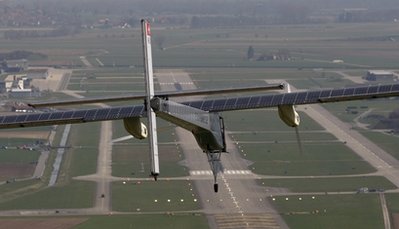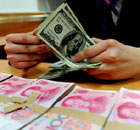Science and Health
Solar-powered plane makes successful maiden flight
(Agencies)
Updated: 2010-04-08 09:48
 |
Large Medium Small |
Using almost 12,000 solar cells, rechargeable lithium batteries and four electric motors, Piccard and co-pilot Andre Borschberg plan to take the plane around the world. They will make regular stops to switch places and stretch after long periods in the cramped cockpit -- and to show off their aircraft.
The circumnavigation will take time. With the engines providing only 40 horsepower, the plane will perform like a moped in the sky, at an average flight speed of 44 mph (70 kph). The trip will be divided into five stages -- keeping the plane in the air for up to five days at a time.
Solar flight isn't new, but Piccard's project is the most ambitious.
In 1980, a fragile ultra-lightweight experimental solar plane called the Gossamer Penguin flew short demonstration flights with one pilot on board. A bigger project called the Solar Challenger flew a single pilot from France to England in 1981 in a trip lasting more than five hours.
Solar plane technology recalls the early days of manned flight, and the slow ascent of the Solar Impulse was somewhat reminiscent of the Wright brothers' pioneering experiments in 1903.
Wilbur and Orville Wright also progressed from short hops to longer flights after 1905, reaching average speeds above 30 mph (48 kph) and only slightly slower than the Solar Impulse.
The loud clicks of the Swiss plane's four propellers added another hint of nostalgia. And designers acknowledged the same worries that preoccupied the first fliers.
"The first crucial question was: Do we have enough power to fly?" said Borschberg. "The second crucial thing was: Are we capable of landing this airplane, is it controllable?"
"It was two hours of deep emotion," he added, calling the test flight the high point of seven years of work on the project. "The airplane has landed but we have not yet landed."
Borschberg followed the flight in a helicopter. Below waited numerous people involved with the project and Piccard, who comes from a long line of adventurers. His late father, Jacques, was an oceanographer and engineer who plunged deeper beneath the ocean than any other man. His grandfather Auguste, also an engineer, was the first man to take a balloon into the stratosphere.
On Wednesday, the Solar Impulse reached an altitude of 5,500 feet. After a gentle landing, Scherdel emerged from the cockpit with his arms raised, and the team broke open bottles of champagne.
When the plane attempts to circle the globe, the team will have to monitor conditions closely to ensure the aircraft follows the best weather. Ground crews will stay close to provide service at each stop, he said.
"Round-the-world will seem impossible until we do it," Piccard said. "Today is an absolutely incredible milestone."







